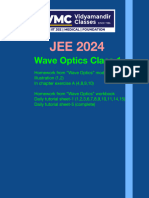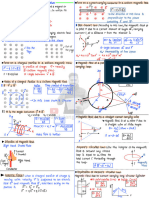Wave Optics 1 Page Notes
Uploaded by
wytaziWave Optics 1 Page Notes
Uploaded by
wytaziWave Optics # coherent and incoherent sources : The sources of light ,
which emit
# Wavefront : The locus of all particles of the medium vibrating in continuous light waves of the same wavelength ,
same frequency &
same phase at a given instant is known as wavefront -
in same phase or having a constant phase difference are known as
Spherical wavefront : When the source of light is a point source ,
the coherent sources .
wavefront is spherical "grays Two sources of light do not emit light waves with a constant
--
D
J
Navefront phase difference are called incoherent sources
-&
.
source Interference of lights
Cylindrical Havefront : When the light source is linear, the wavefront It is the phenomenon of redistribution of
energy on account of
is Cylindricalwavefront
linear >
-
superposition of light waves from two coherent sources.
Source Interference pattern produce points of maximum and
* minimum intensity. Points where resultant intensity is maximum ,
* Plane Wavefront : When the point source or linear source of light is at interference is said to be constructive and at the points of
very large distance ,
a small portion of spherical or cylindrical wave -
destructive interference , resultant intensity is minimum .
-front appears to be plane Such .
a wavefront is known as Plane wave -
#Intensity distribution
-
front If a b are the amplitudes of interfering waves due to two coherent
-
Light rays
sources and ! is constant phase difference between the two
Plane *
wavefront- D
waves at any point P, then the resultant amplitude at P
will be G b + 2 abcosd
R =
+
According
=
# Huygens principle : to Huygens principle ,
-
Every point on given wavefront (primary wavefront) acts as a Resultant intensity I =
I +
, If + 2 IE,E, Cos
fresh source of new disturbance called , secondary wavelets
. When cosd = I -when cosd = -I
The secondary wavelets spread out in all the direction with Imax /E + +Es)
=
, Imin =
(II +E2)
,
-
the speed of light in the medium primary
Secondary
.
&
wavefront
-
A surface touching these secondary Conditions for sustained interference of light
Wave
wavelets-
*
wavelets tangentially in the forward front ⑭The amplitudes of waves from two sources should preferably
⑭
direction at any instant gives the new be equal .
⑭ I
(secondary) wavefront at that instant ↳ The waves emitted by the two sources should either be
in phase or should have a constant phase difference and
#
Laws of reflection by Huygens principle have frequency
same .
-
H Al ↳ The two sources should be very narrow .
L &
O
p
Sunil Jangra Physicsexperiment
Young's double # slit : was the first to demonstrate
-
I -
t
L
X
r ( the phenomenon of interference of light Using
.
two slits
BI
illuminated by monochromatic light source , he obtained bright
For every point on Wavefront AB , a corresponding point lies on and dark bands bands of equal width placed alternately.
the reflected wavefront A'B' .
These were called interferencefringes .
so , comparing two triangle ABAB' & AB'A'B · screen
4 Dark
We find that ,
AB A'B = =
Ct BB =
common (A = LA go =
3 Bright #
3 Dark
Thus two triangles are congruent ,
hence Li = L
2 Bright C
2 Dark
Laws of refraction by Huygens principle S 1 Bright
- I Dark
air
d ⑭ Central Bright fringe
~ Incident
it
From AABB' and AA'B'B , shell's Dark (or central maximal
wavefront 1 Bright
law can be proved. *
B 1i
Ct
BI o
S2 2 Dark
Sni CtBB'
= =
2 Bright
r g 3 Dark
Vt
glass
- 3 Bright
All
#
V 4 Dark
-
refracted ↑ D D
wavefront
* Intensity
# Effect on
frequency wavelength and speed during refraction
.
M
,
When a wave passes from one medium to another then change in
speed v takes place , wavelength X also changes whereas its
ii it in 2x
,
frequency o remains the same .
O pathe difference
For constructive interference (ie formation of bright fringes) Diffraction of light : It is the phenomenon of bending of
Fornt bright fringe light around corners of an obstacle or aperture in the
Path difference <
<G nx H= 1 2
,..... path of light
= = .
,
The intensity pattern is exactly symmetrical on both side , of #Diffraction due to a
single slit:
*
the intensity graph
. Note : Size of the slit is
~D ark
bright fringe comparable to wavelength
>
where n =
0 for central .
&
n =
1 for first bright fringe n =
2 for second bright fringe & so on
Dark
.
··
-
-
Xp
nx4 3
.
: =
; n 0, 1 2
al
=
, , -
V
⑭ For destructive interference (ie formation of dark tringe)
For nt dark fringe a>
Path difference =<
A (24-1)
=
9
↑ D -
-
-
where n= for first dark fringe n =
2 for and dark fringe 8 so on .
S
= distance of nt dark fringe from the centre.
-
Condition for nth secondary maximum is
(2H 1) Path difference asinon (2n + where
: Xn
4 n = 13
1) n 1 ,2 , 3
, . . .
=
;
= - = =
=
The intensity pattern is exactly symmetrical on both sides of the
-
Condition for nt secondary minimum is
intensity graph
. Path difference =asinon =
nx where n = 1 , 2, 3, 4
,
Fringe width : The distance between any two consecutive -
Width of secondary maxima or minima
bright or dark fringes is known as fringe width B Where a= Width of slit.
xD
=
.
Fringe D distance of screen from the slit
width B
<*
= = .
Angular fringe B= ↳ Width of central maximum
** Width O 2x
:
,
= =
If W, We are widths of two slits , I , Is are intensities of light Angular fringe width of Central maximum 8=
24 a
coming from two slits ; a , b are the amplitudes of light from
these slits ,
then ↳
Angular fringe width of
secondary maxima or minima
Sunil Jangra Physics1
G2
k # late p
; Imax
= =
=
=
T2
Imin (a-b)2
* Fresnel distance : It is the minimum distance a beam of
When entire apparatus of Young's double slit experiment is light has to travel before its deviation from straight line path
immersed in a medium of refractive index u , then fringe becomes significant
width becomes
B
Fresnel distance , If
=
x x 1
= = =
ud el
When a thin transparent plate of thickness to refractive
index u is placed in the path of one of the interfering waves
,
fringe width remains unaffected but the entire pattern
shift by
(n
1)tB
(n 1) +
B
(x = -
= -
Colour of thin films : A soap film or a thin film of oil
spread over water surface , when seen in white light
appears . This effect
coloured can be explained in terms
of Phenomenon of interference·
You might also like
- 12th Physics Formula Booklet by Umesh RajoriaNo ratings yet12th Physics Formula Booklet by Umesh Rajoria2 pages
- Origin-and-evolution-of-Universe-and-Earth-orientation-of-Earths-Rotation_1692184727No ratings yetOrigin-and-evolution-of-Universe-and-Earth-orientation-of-Earths-Rotation_169218472713 pages
- Huygens Principle and Laws of Rfraction and ReflectionNo ratings yetHuygens Principle and Laws of Rfraction and Reflection6 pages
- A2 Physics - Magnetism and ElectromagnetismNo ratings yetA2 Physics - Magnetism and Electromagnetism3 pages
- Determination 446 Pesticides Residue by GC Ms and LC MsNo ratings yetDetermination 446 Pesticides Residue by GC Ms and LC Ms32 pages
- The Five Generic Competitive StrategiesNo ratings yetThe Five Generic Competitive Strategies39 pages
- Promotional Strategies & Print Ad For Cold Creams100% (1)Promotional Strategies & Print Ad For Cold Creams12 pages
- Brian Tracy 18 Pasos para Programar La Mente para El ExitoNo ratings yetBrian Tracy 18 Pasos para Programar La Mente para El Exito19 pages
- Learn: Half Yearly Examination (2013 - 2014) Class Ix Foundation of Information Technology Time: 3 Hrs. M.M.: 90No ratings yetLearn: Half Yearly Examination (2013 - 2014) Class Ix Foundation of Information Technology Time: 3 Hrs. M.M.: 9023 pages
- Control CL Commands With Command Exit Programs - Part 1No ratings yetControl CL Commands With Command Exit Programs - Part 18 pages






























































































